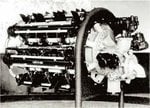I am searching for pictures and drawings of this most unusual engine. There is only a very little on-line. There used to be an intersting post for this in the Classic Warbirds Forum which unfortunately, now seems to be defunct (what happened to this forum; did it move/re-name/ or just go extinct?).
Putnam Books (UK) also published the annual book of World Aircraft Engines 1945 --> onwards which contained more pictures. Unfortunately I no lponger have access to a copy. Does anyone?
All other technical information would be most welcome.
Thanks.
Putnam Books (UK) also published the annual book of World Aircraft Engines 1945 --> onwards which contained more pictures. Unfortunately I no lponger have access to a copy. Does anyone?
All other technical information would be most welcome.
Thanks.

